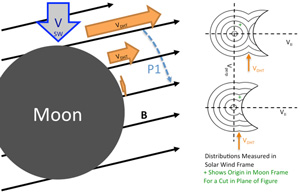2012 ARTEMIS SCIENCE NUGGETS
Lunar Precursor Effects in the Solar Wind and Terrestrial Magnetosphere
by J. S. Halekas, UC Berkeley Space Sciences Laboratory
Introduction
Traditionally, we have viewed the Moon as a simple absorber of the flowing solar wind plasma, with a wake extending downstream, but few effects upstream from the sunlit surface of the Moon. Contrary to this simple view, though, recent ARTEMIS observations show a host of plasma effects extending ~10,000 km or more upstream from the Moon.
| Figure 1. Cartoon of the foreshock-like region extending upstream from the lunar surface, with ion effects near crustal magnetic fields, and electron effects extending to large distances upstream along interplanetary and/or magnetospheric magnetic field lines. |
Results
The two ARTEMIS probes observe significant precursor activity upstream from the Moon, when magnetically connected to the dayside lunar surface. ARTEMIS measurements show that part of the incoming plasma reflects from a combination of magnetic and electric fields near the lunar surface, producing an anisotropic population that streams back along the magnetic field into the incoming plasma. This reflected population in turn affects the incoming plasma, producing waves and creating a disturbed region extending upstream along the magnetic field direction from the sunlit side of the Moon. The most common signature consists of high levels of whistler wave activity near half of the electron cyclotron frequency, driven by cyclotron resonance between the anisotropic reflected electron population and Moonward-propagating waves. These waves can in turn affect incoming plasma, and we observe significant perpendicular electron heating and plasma density depletions in some cases. This precursor activity extends to distances of many thousands of km, in both the solar wind and terrestrial magnetosphere.
In the magnetosphere, electrons reflect from a combination of magnetic and electrostatic fields above the lunar surface, forming loss cone distributions. In the solar wind they reflect by similar mechanisms, but instead of forming loss cone distributions, they generally form conics, as a result of reflection from an obstacle moving with respect to the plasma frame, as illustrated in cartoon form in Fig. 2. This process, in many ways highly analogous to effects observed in the terrestrial electron foreshock, efficiently produces electron distributions with significant free energy upstream from the Moon.
| Figure 2. Schematic illustration of how conic distributions form upstream from the Moon, as a result of electron reflection from the moving obstacle formed by the electrostatic and magnetic fields near the lunar surface. |
In the magnetosphere, we observe similar particle and wave effects along magnetic fields connected to the surface, but with even higher amplitude, since a much less significant damping population exits. We also observe broadband electrostatic modes driven by beams of secondary electrons and/or photoelectrons accelerated outward from the surface. These beams are driven by non-monotonic potentials produced near the surface, as previously observed by ARTEMIS [Halekas et al., 2011], and modeled by Poppe et al. [2011, 2012]. We also occasionally see waves near the ion cyclotron frequency in the magnetosphere. These lower frequency waves, which may result from the presence of ions of lunar origin, modulate the whistlers described above, as well as the electrons.
Conclusion
ARTEMIS has made the most comprehensive plasma measurements ever around the Moon, utilizing its unique orbit and two-probe viewpoint. To our surprise, these measurements indicate that solar wind and magnetospheric plasma can see the Moon coming before it arrives. Taken together, our observations suggest that the presence of the Moon leads to the formation of an upstream region analogous in many ways to the terrestrial electron foreshock.
Reference
Halekas, J.S., A.R. Poppe, W.M. Farrell, G.T. Delory, V. Angelopoulos, J.P. McFadden, J.W. Bonnell, K.H. Glassmeier, F. Plaschke, A. Roux, R.E. Ergun (2012), Lunar Precursor Effects in the Solar Wind and Terrestrial Magnetosphere, J. Geophys. Res., 117, A05101, doi:10.1029/2011JA017289.Biographical Note
Jasper Halekas is an Associate Research Scientist at the U.C. Berkeley Space Sciences Laboratory. He has been studying the Moon since he was a graduate student, and is now a member of the DREAM2 SSERVI team, acting deputy PI of ARTEMIS, Guest Investigator on the LADEE mission, and a LEAG Executive Committee member. He is also currently preparing for the launch of MAVEN and starting development on the SPAN electron analyzers for the SWEAP suite on Solar Probe Plus.
 Please send comments/suggestions to
Emmanuel Masongsong / emasongsong@igpp.ucla.edu
Please send comments/suggestions to
Emmanuel Masongsong / emasongsong@igpp.ucla.edu

